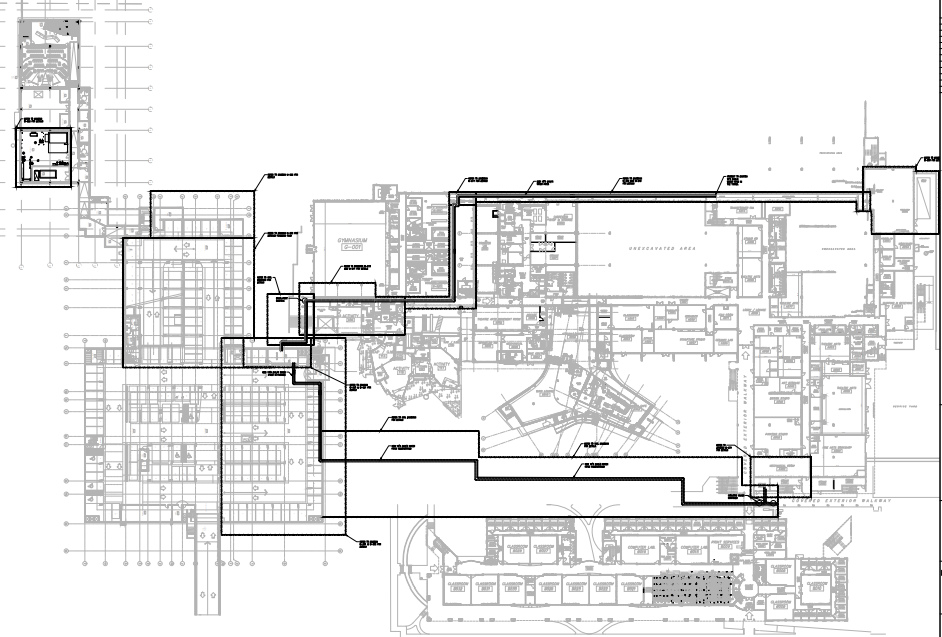Central Heating Plant
LATEST UPDATES
See the latest updates here.

INTRODUCTION
The central heating plant (CHP) project will take place from October 2022–March 2023. The project will bring a new CHP, replacing our existing one from 1969, to provide heating to many buildings on campus. The new CHP will have seasonal energy efficiency of over 85%, significantly contributing to the government’s efforts to reduce greenhouse gases through Clean BC and improve Facility Condition Index (FCI).
PROJECT TIMELINE
Construction across campus will begin October 11 and continue into early Spring 2023. Expect to see construction activities in different areas in the underground parkade and throughout the exterior corridors located between A and C Buildings. This includes construction fencing placed around the central courtyard and around the stairs located at the west end of the gym for excavation activities that will begin late November 2022 and continue until March 2023 (see map above).
HISTORY
The A Building central heating plant on campus is original (1969) and identified as end of life. It currently serves most of campus (excluding Library building and T Building), including providing heating for the domestic hot water on campus.
In 2014, When in design phase of our New Science and Technology Building, it was identified that the building required a large heating plant to meet code requirements (lab buildings are particularly energy intensive), however, the heat recovery systems in the building made the actual load much less than typical buildings. The new Science and Technology Building (certified LEED Gold) is beside the Library building (certified LEED Gold), which also has a heating boiler which is underutilized as it is a Geothermal building. The New Central Heating Plant project was proposed to the Ministry of Education in 2014 as a three-phase project. Funding was awarded for Phase I including $500,000 in Fortis funding through new construction program. In 2015, we received additional funding for Phase II through the Carbon Neutral Capital Program.
We have completed phase I & II of this project; in 2020, we issued ITT for Consultants for Design and Analysis – included detailed design scope from L to B. In Nov 2020 – Fortis Energy Study Approval Letter – $75,000 in funding to do a more detailed energy analysis of options. The Detailed Thermal Study recommends we integrate the central plant with the newer plant installed in L Building instead of upgrading the A Building Heating Plant. To integrate the plants, two new supply and return loops will be installed from Plant “L to B” and Plant “L to A” (to the utility tunnel serving A, C and G buildings).
The detailed design and tendering is complete and we plan to start construction this fall 2022.
With the existing heating loads, the new hot water plant is expected to operate with seasonal efficiency of above 85%, resulting in fuel savings of approximately 7,840 GJ or 25% of our current fuel usage.

BENEFITS
Strategic Alignment: This initiative is in line with the government’s efforts to reduce greenhouse gases through Clean BC and improve Facility Condition Index (FCI) and reduce deferred maintenance costs. It also aligns with Langara’s strategic plan to remove A Building, which involves removing our dependence on its heating plant. Our GHG’s reductions will also help towards our future Association for the Advancement of Sustainability in Higher Education (AASHE) Sustainability Tracking, Assessment & Rating System (STARS) rating.
Energy and Emissions Reduction: The new heating plant has more efficient technology, and in addition, the system, piping and controls have been designed to make use of the condensing/more efficient range of the boilers as the new buildings are generally designed for low temperature, (the existing Library, LSU, C and Science & Technology Buildings).
Innovation: Continuing to centralize the heating and including features in the design for future integration, will better prepare us to take advantage of renewable energy opportunities in the future with an ability to replace source at single point or introduce at various points across campus (example: add to the highly effective 160 geothermal wells already on campus).
Infrastructure improvements: The relocation and renewal of the heating plant would improve the FCI of all buildings on campus, including decreased risk to infrastructure as a result of loss of heat.
Cost Effectiveness: Serving the campus from a new central plant would minimize disruption, risk and cost when A Building renewal is scheduled and required, as well, this minimized investment required to provide heating for our new Building. Continuing to centralize the heating plant will minimize operating costs associated with annual inspections of multiple plants. With the new central plant in place, Langara is projected to save $658,667 on energy costs by 2030.